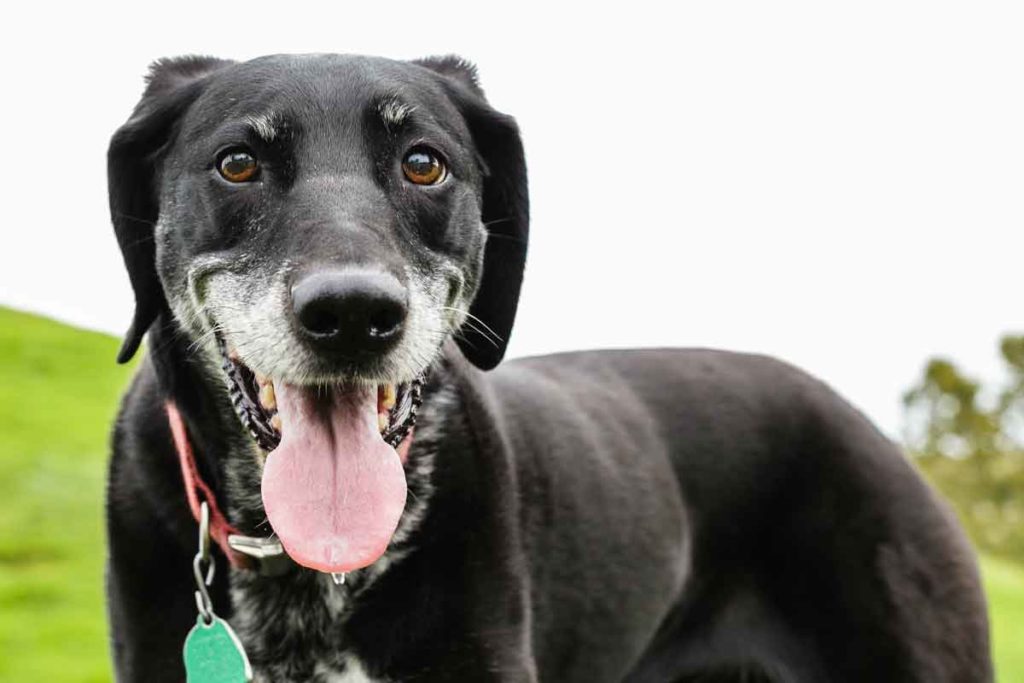Providing exercise for older dogs is an important part of their daily care, but they aren’t the energetic and athletic puppies they used to be. Aging can often bring mobility issues and joint discomfort in dogs, making more strenuous activities challenging and unpleasant.
How can you help keep your senior dog active into their golden years? How can CBD + CBDA help your senior dog move more comfortably?
Table of contents
- Benefits of exercise for senior dogs
- What to keep in mind when exercising with your senior dog
- Senior-friendly exercises
- How can ElleVet’s CBD + CBDA help keep seniors active?
Benefits of exercise for senior dogs
Seniors naturally lose muscle mass, strength, and their sense of balance as they age, according to veterinarian Dr. Barbara Butler. Older dogs are also at increased risk of obesity, cancer, heart problems, cognitive decline, and joint discomfort.
It’s easy to mistake your senior’s new behaviors—increased napping, moving slower—as proof that they don’t need as much or any daily exercise. However, exercise is a crucial part of helping senior dogs maintain quality of life as they age.
Exercise helps keep senior dogs’ minds stimulated and their bodies strong. As the saying goes, “use it or lose it.” Having an active lifestyle is critical to maintaining mobility, promoting overall health, and preventing weight gain, which can increase risk of and exacerbate health issues.
Here’s what to keep in mind when exercising with your senior dog
Senior dogs have unique needs and abilities, and every dog is different. It is important to figure out what will work best for your senior dog when developing an exercise plan. Some possible considerations include:
- Strength and endurance – Your senior dog likely can’t keep up with their usual long hikes and extended games of fetch anymore. It is normal for dogs to have lower energy levels as they age. The focus of exercising a senior dog is to keep them moving and mobile, not to tire them out. Moderation and consistency are essential—instead of one hour-long session of rigorous exercise, consider shorter, more frequent low-intensity activities throughout the day.
- Joint discomfort – Older dogs often develop mobility issues. In fact, approximately 80 percent of dogs older than eight experience some form of joint discomfort. As joint cartilage deteriorates, worsening inflammation can cause discomfort and decreased mobility, significantly reducing quality of life. Watch for common signs of joint discomfort like:
- Slow to get up in the morning
- Avoiding stairs or the car
- Walking stiffly or slowly
- Less interaction with family and other pets
- Loss of interest in toys and activities
Senior-friendly exercises
When your dog slows down or experiences discomfort, high-intensity activities that are hard on their joints won’t cut it anymore. Regardless of your dog’s physical limitations, there is always something fun to do that helps maintain their well-being.
Here are some low-impact, senior-friendly exercises to keep your dog moving:
Walking
Your dog might not be able to go on longer walks anymore but they still need the opportunity to get outdoors every day to sniff, stretch their legs, and get some fresh air. Most dogs love a good walk and it’s an easy everyday activity that puts less impact on their joints than running.
Let your dog set the pace of your walk—heads up, it will probably be much slower—and keep it fairly short. Incorporate plenty of sniff stops for mental stimulation.
Be aware of how your dog feels during and after your walk. If they are showing signs of discomfort or have labored breathing, take a break and cut back your distance and speed next time.
Whenever your senior dog is exercising outside, it is important to keep the weather in mind. According to Top Dog Health, older dogs can be more sensitive to extreme temperatures. Bring water and stay in the shade to avoid overheating. Protect their paws from hot pavement and ice and salt by having them wear booties, which can also help their balance in slippery conditions.
Swimming
Swimming is an excellent total-body, low-impact workout. Getting in the water by either swimming or walking on an underwater treadmill is popular for physical therapy and rehabilitation. It can help dogs build strength and maintain mobility while minimizing joint discomfort.
Senior dogs should wear a life jacket to keep them safe while in the water. Owners should also keep in mind that certain breeds like bulldogs, pugs, and other brachycephalic dogs are prone to drowning and should not swim.
Puzzles
Puzzle toys and snuffle mats than dispense treats are a great way to engage your senior dog in some mental exercise. They can also require some light physical movement depending on the level of difficulty. Hide a Kong toy stuffed with peanut butter or your dog’s favorite treats around the house or roll up a towel with treats inside to make your pup work for it.
Scattered feeding involves spreading kibble across the floor or throughout the backyard for a fun mealtime scavenger hunt. This very low-impact form of exercise not only encourages your dog to use their nose, but also to move around to search for their food. This uses their core muscles and gets their joints moving.
Training
Old dogs can learn new tricks. Learning new things is obviously exercise for the mind, but tricks can also be good physical exercise, notes Fear Free certified trainer Laura Torelli. Your dog will use their core muscles and gently engage their joints when they go from sitting to laying down to standing up again.
And some tricks are more than just fun and exercise—they can help with an aging dog’s daily activities, too. Train your senior dog to use a stepstool to climb onto the couch rather than jumping or teach them to put their front paws up in the car and wait for your help getting inside.
How can ElleVet’s CBD + CBDA help keep seniors active?
CBD + CBDA is a safe and effective option for addressing joint discomfort in dogs by working to improve discomfort and reduce inflammation. ElleVet’s CBD + CBDA helps your dog by modulating their inflammatory response and perception of discomfort.
By keeping dogs active well into their later years, CBD + CBDA can play an important role in helping senior dogs maintain a good quality of life. At ElleVet, senior dogs are our favorite customers because they tend to respond incredibly well, often when nothing else works. Keeping sweet seniors happy is what we do best!
As always, consult your veterinarian if your dog shows signs of joint discomfort. For any questions about ElleVet’s CBD + CBDA products or how CBD can help your senior dog have the best quality of life possible with less discomfort, give us a call (844-673-7287) or send us an email ([email protected]). We are here to help.









